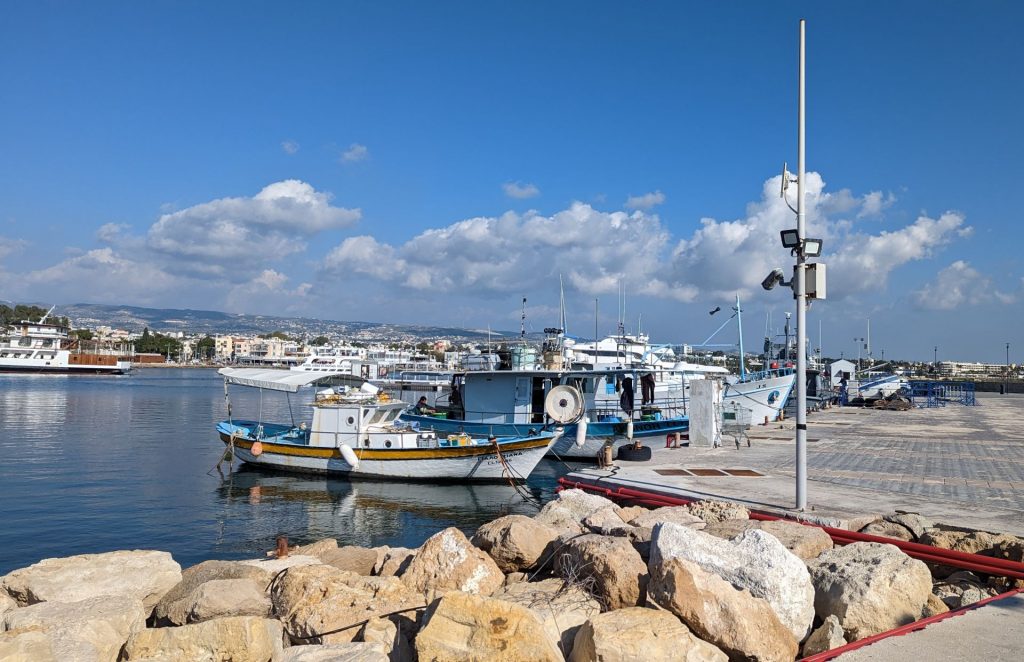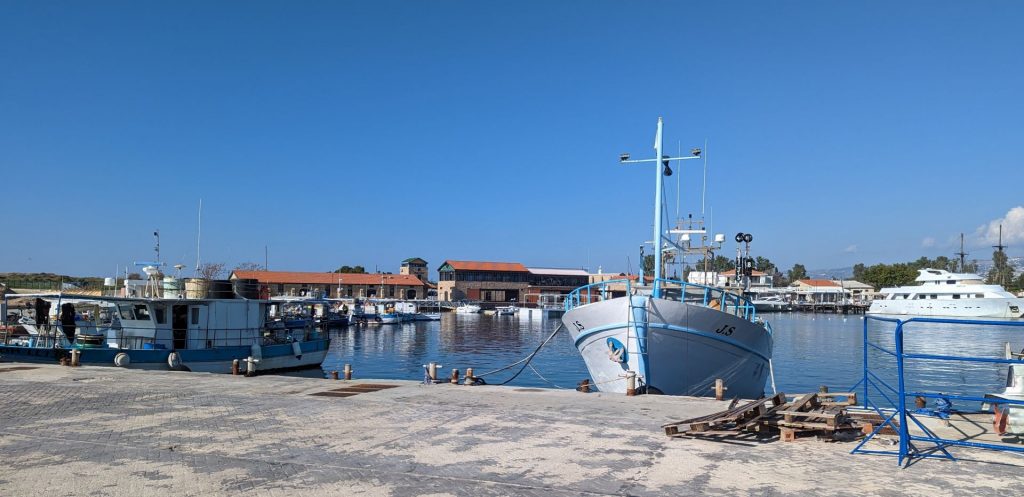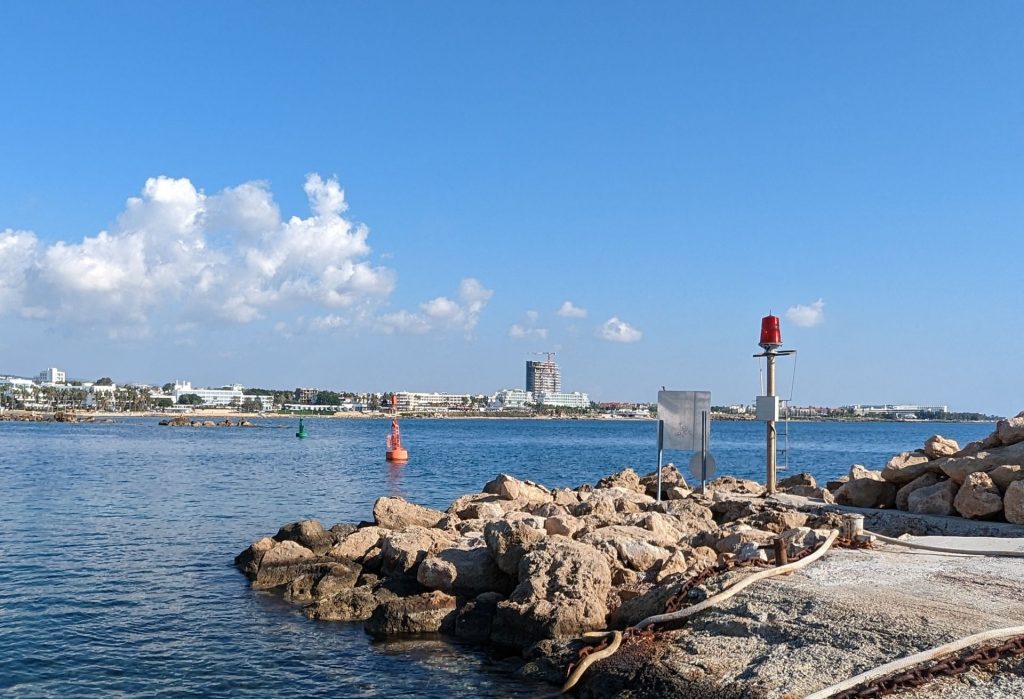We awoke to a beautiful day and started with a full breakfast at the hotel. I want to give a shout out to the hotel. It is the Amphora on Poseidonos Avenue in Kato Paphos. It included a free breakfast, and the offerings were extensive. It is right on the sea in a lovely area. We had a private balcony. The rooms are nice. There is an outdoor pool (it was closed, sadly), indoor pool, sauna, and exercise room. There is a promenade by the sea that goes for several miles. We were there in the off season so consider that, but we paid only $71/night. It was a steal. We *highly* recommend it. Here are some pics:
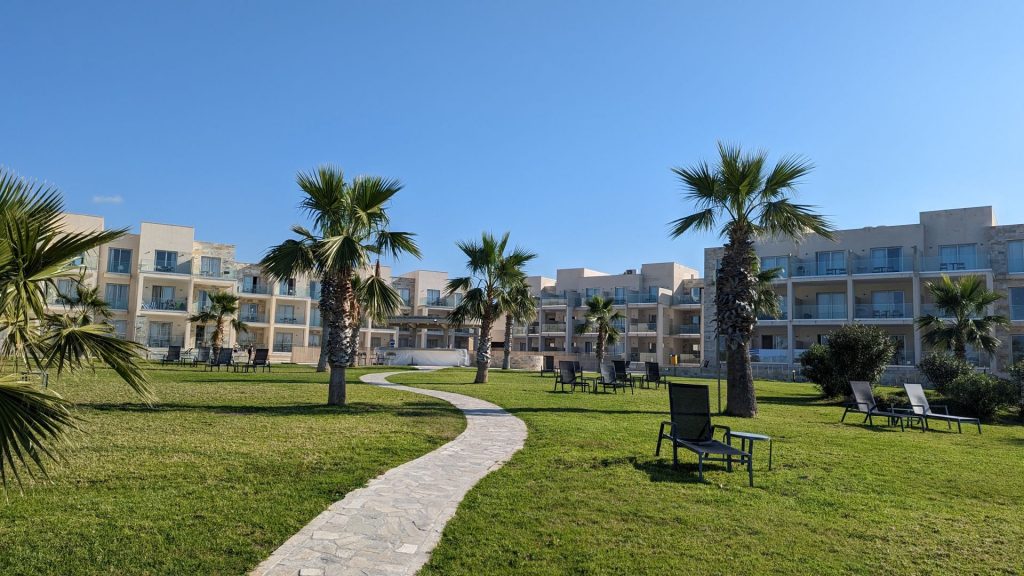
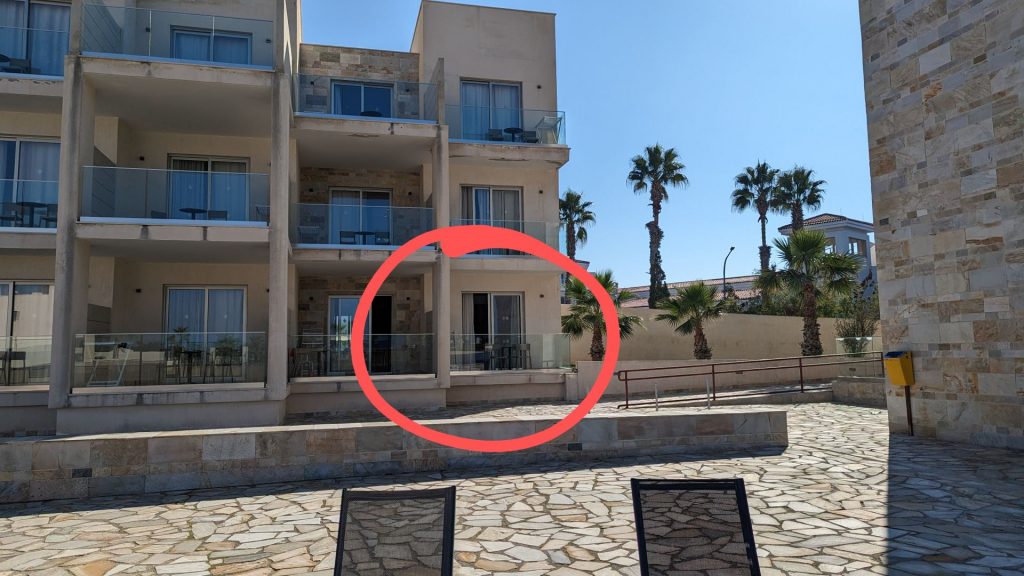
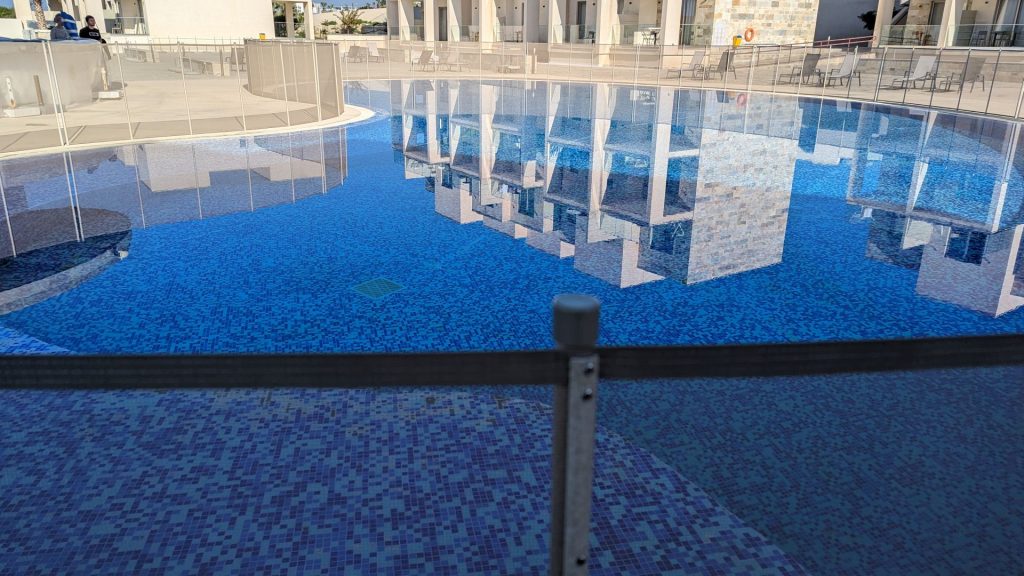
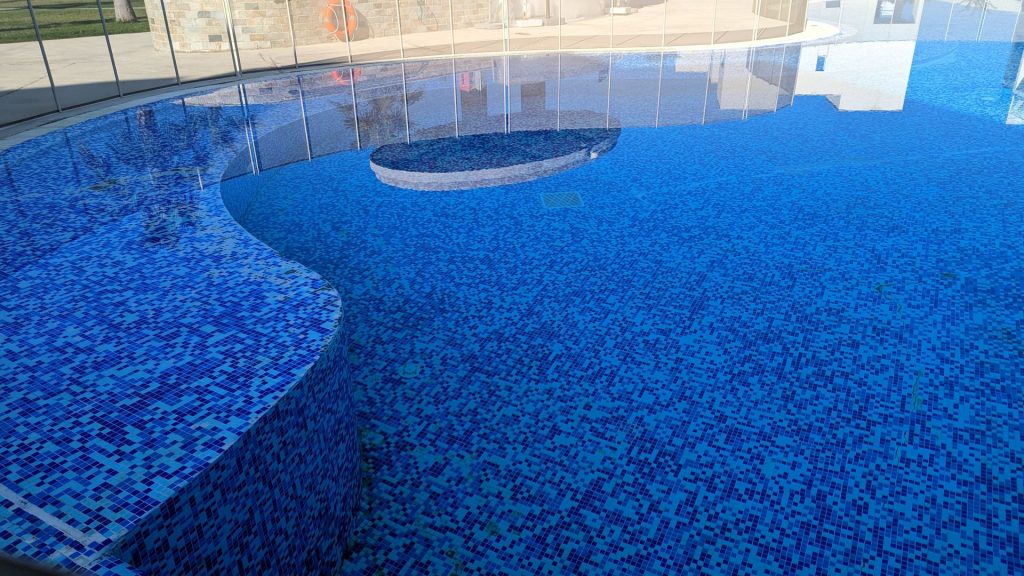
I guess that is a “down side” to arriving in the winter.
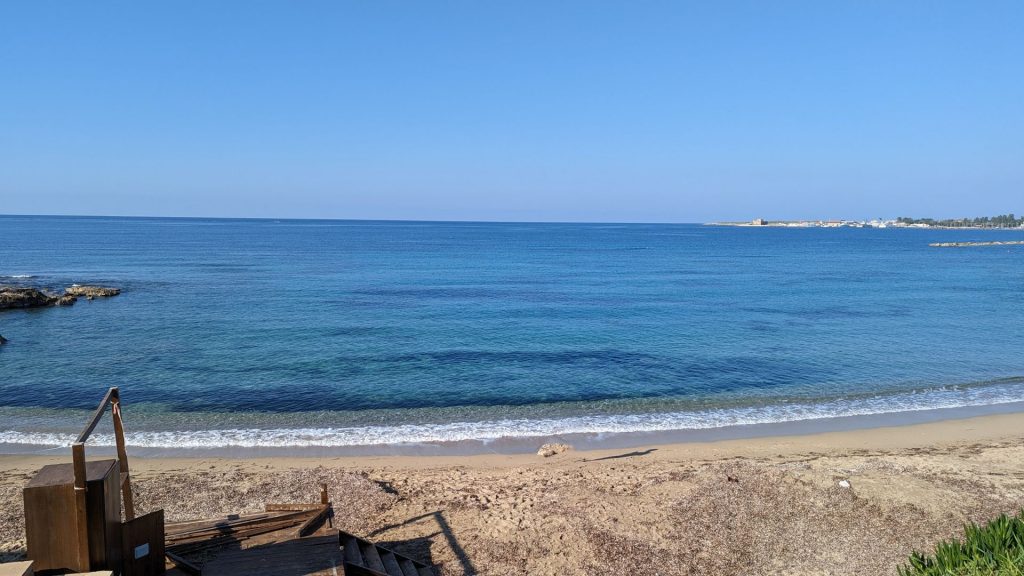
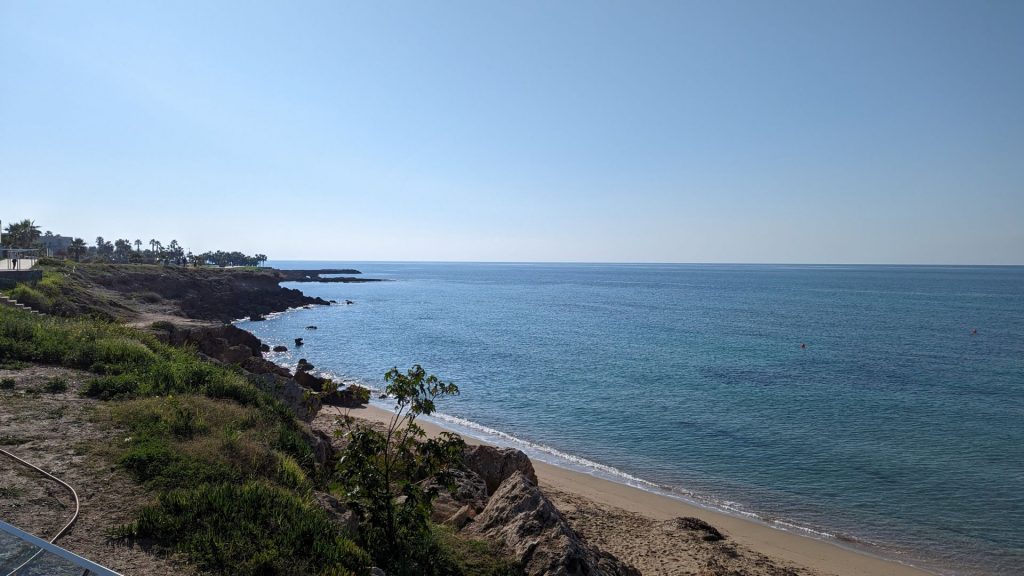
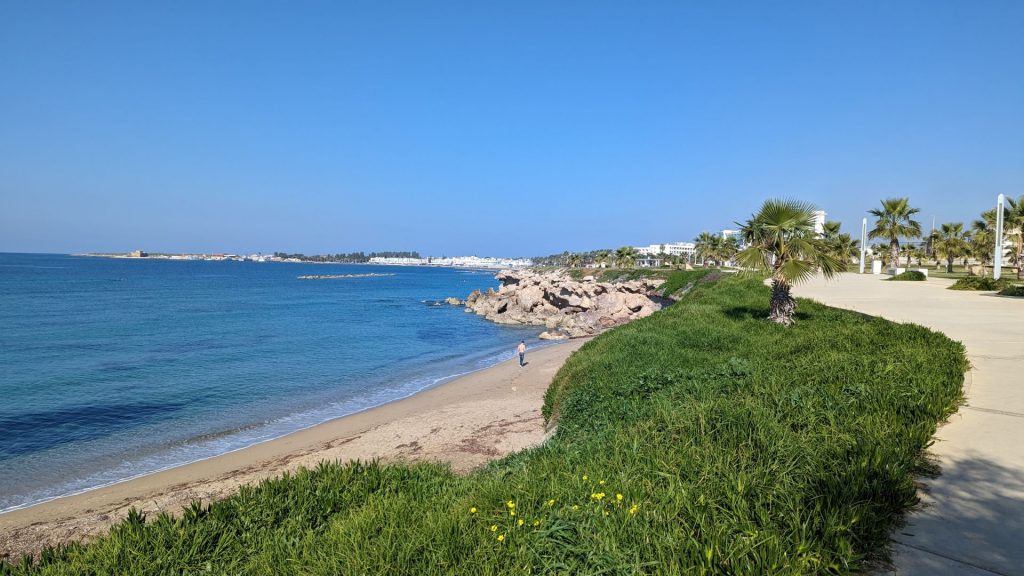
On the agenda for today was a trip to Kato Paphos (or Pafos) Archeological Park, followed by a visit to the Tombs of the Kings. Part 1 of today’s post includes the former. Part 2 covers our visit to the Tombs of the Kings.
Spoiler alert: the main points of interest are the mosaics. I enjoyed them in and of themselves, but I like the stories behind them even more. Of course I will be sharing them. Those of you who have studied Greek mythology (and those who took Classical Mythology at St. Kate’s to fulfill your fine arts requirement) will be familiar with the stories.
We started Day 1 at 6:30 a.m. and ended our sightseeing at approximately 4:30 p.m. This was Michael’s plan to ensure that we made the most of the daylight each day. Oddly enough, we woke up later on Day 2 (maybe 8:00ish?), had a leisurely breakfast, followed by (Michael’s idea) a walk on the promenade. Then we each took a shower. This slow pace was either a good sign that Michael was finally in vacation mode or that his back was stiff and he wanted as much “non-walking” time as possible. (It was the latter.) In any event, it was a relaxing way to start the day. . . and we still had plenty of time to do the sightseeing we had planned for the day.
The Archeological Park is quite large. We will share just a bit of it, for which you are probably grateful. This is how big it is:
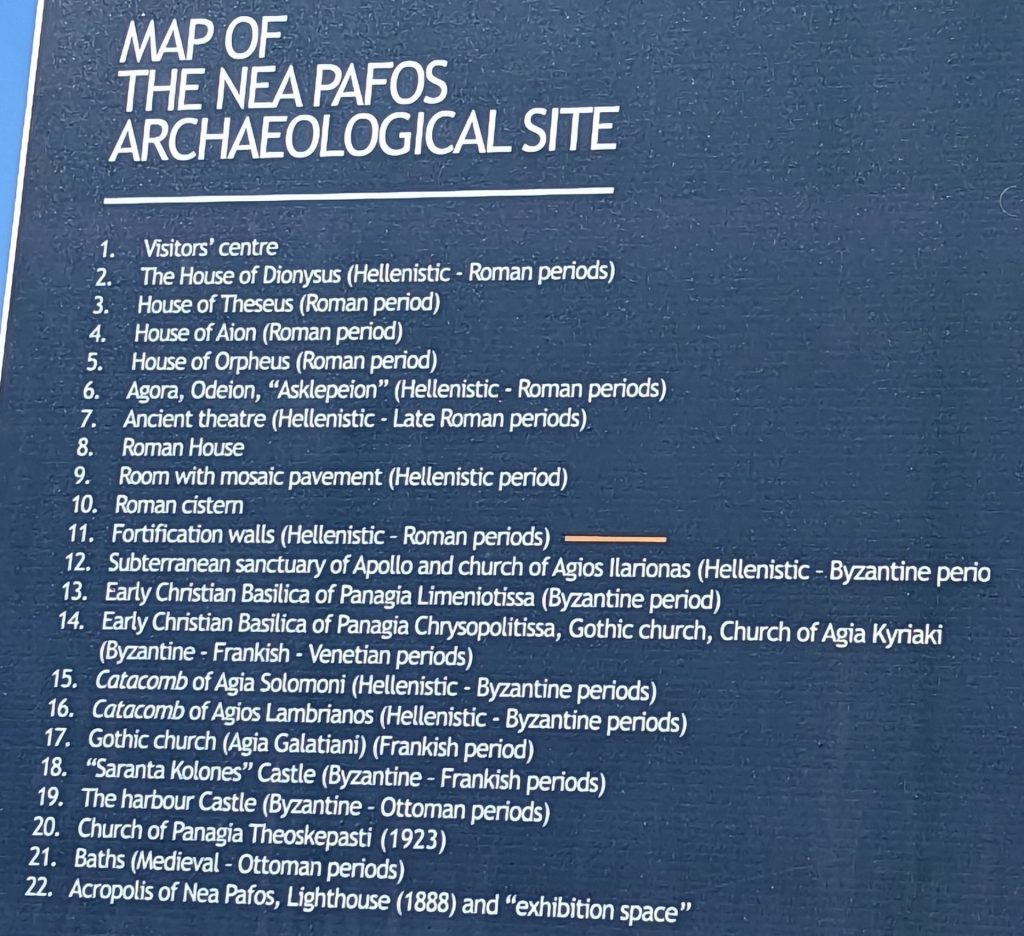
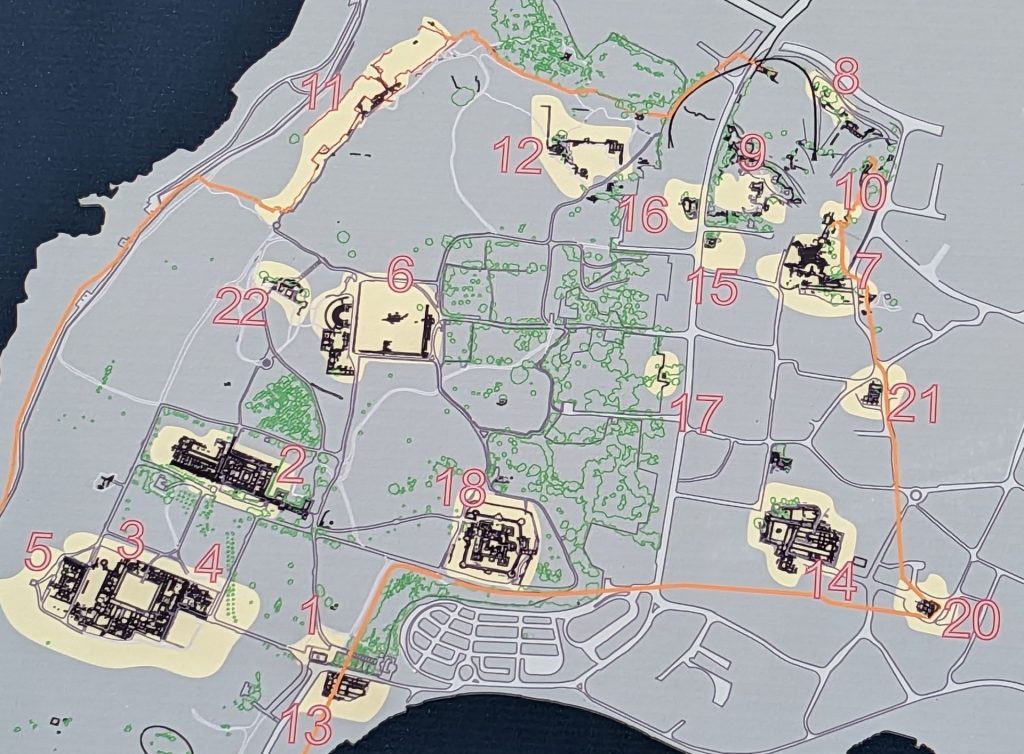
We had planned to visit the old city of Pafos in the village of Kouklia, which was built for the first time in the 12th century B.C., on Day 1 but we ran out of time. So we skipped it entirely and visited the new city on Day 2 instead. This is where the Archeological Park is located. Nea Pafos (where we were today) was founded at the end of the 4th century B.C., by king Nicolas, the last king of Pafos. He built the city here around a bay that was going to become the port of the city. Nea Pafos became the economic and commercial center of the kingdom. It was protected by tall walls and covered an area of about 950,000 square meters.
During the 2nd century B.C. the Ptolemies transferred the capital of Cyprus to Pafos because of its large port and proximity to Alexandria. In 58 B.C., the Roman Republic annexed Cyprus. The Roman proconsul resided in Pafos and the city achieved even greater importance. During the end of the 2nd century and the beginning of the 3rd century A.D. rich public and private buildings were erected. Many of their ruins have survived, and those are what we saw. The ruins indicate that the people living here had a high standard of living and intellectual level.
At the beginning of the 4th century A.D., Pafos was destroyed by earthquakes (you might notice that this is a theme in Cyprus). Pafos was reconstructed, but the capital moved to Salamis.
The House of Dionysus
This site was discovered by chance during leveling works. I love that! It was first thought to be the residence of the Roman proconsul due to its rich decoration. But after they found the proconsul’s actual palace and found more mosaics in this region, they realized that this type of decoration was common in wealthy residences of this period. The mosaics belong to the most recent buildings that were erected here, on the ruins of older buildings.
This building occupies an area of 2000 square meters, of which 556 are covered with mosaics. God Dionysus, god of wine (one of my personal favorites!), is often represented in the mosaics, so they dubbed this building “The House of Dionysus.” The structure contains more than 40 rooms and includes 15 mosaic floors. The owners were rich.
Below is a picture of the atrium, central courtyard. A colonnaded portico would have opened on all four sides. Of course this isn’t the original roof, but the roof actually did slope towards the center. It collected rainwater which was directed to a cistern underneath the atrium’s floor. The residence also had a central drainage system that was connected with the main drain that ran under the road (the city had a sewage system!).
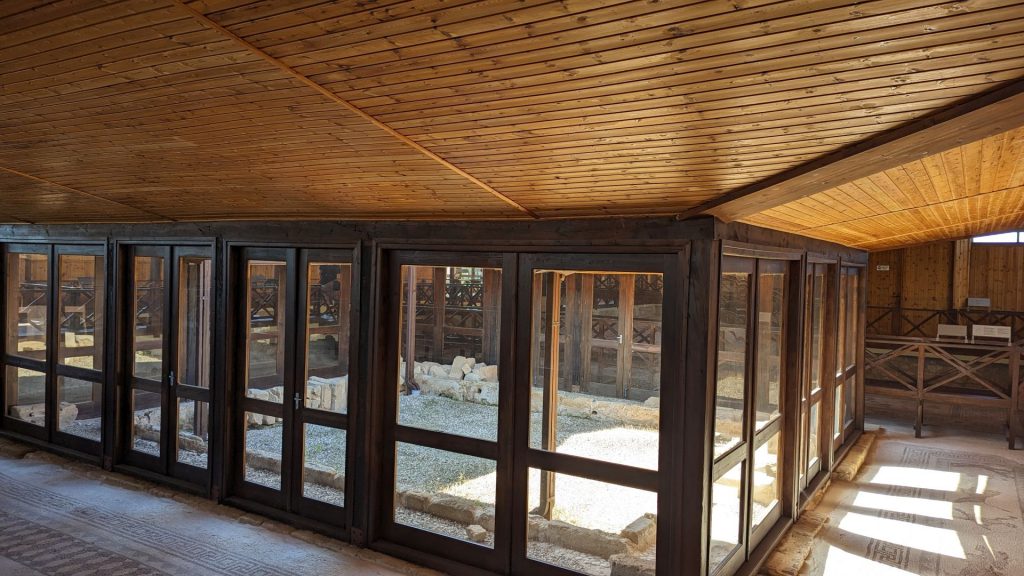
One of the first things one sees when entering the house is the mosaic that originated from a Hellenistic residence of the end of the 4th century. It was found by chance in 1977 during the works for construction of a shed and moved to this location. The mosaic depicts Scylla, a monster that is a combination of a woman, a dog, and a fish. The story is that she wasn’t always a monster, but a beautiful woman. She did not requite the love of a handsome man named Glafkos so he sought the help of the sorceress Circe. Well, Circe was in love with Glafkos and wanted to get rid of Scylla, so she threw magic herbs in the bay where Scylla swam. When Scylla entered the water she was transformed into the monster. She remained in the water for good and sank ships that passed by that spot. That was not very nice of her since the ships didn’t do it to her. I guess she was just a mad monster in perpetuity.
This particular mosaic is made with white, black, and brown pebbles. It was made toward the end of the 4th century-beginning of the 3rd century B.C., making it one of the most ancient mosaics discovered in Cyprus.
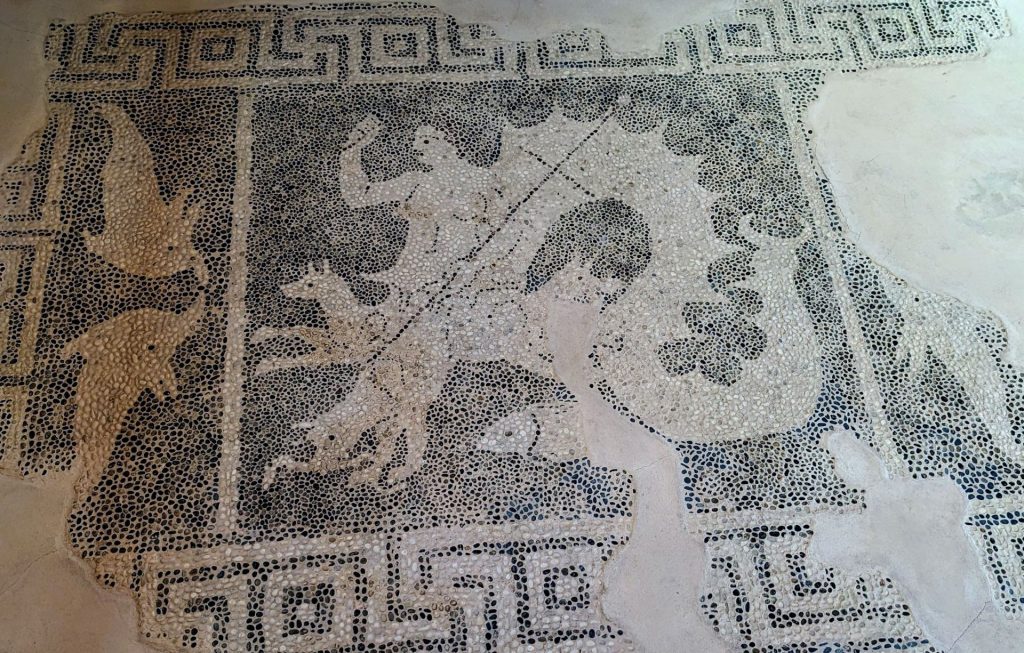
The following mosaic depicts Narcissus admiring himself in the water. As you know, he fell in love with himself and wasted away with love. The gods felt pity for him and turned him into a flower that grows near the water, the narcissus. A large section of the geometric pattern is modern because a part of it was destroyed during leveling works.
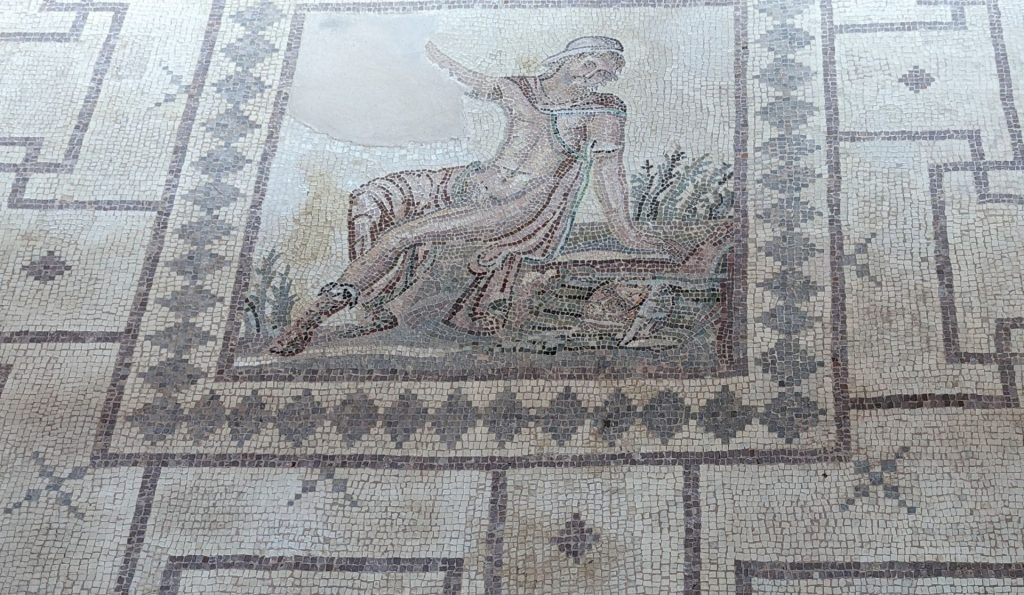
This next mosaic was one of my favorites because it is the basis for a famous story. The two young people are Pyramus and Thisbe, who lived in Babylonia. Their families were hostile to each other so they kept their love a secret. One evening they’d planned to meet under a tree. Thisbe, who was wearing a veil, arrived first. A lioness showed up with her mouth full of blood because she had killed an animal. Thisbe ran and hid in a cave, losing her veil in the process. The lioness took the veil and ripped it apart. When Pyramus arrived, he saw the lioness with the blood-stained veil and thought Thisbe was dead. He therefore thrust his knife into his side and died. When Thisbe later found him dead she used his knife to kill herself. Their names are written in Greek above their figures in the mosaic.
I bet this story sounds familiar to you. This myth is saved by Ovid in “Metamorphoses” and also gave inspiration to Shakespeare for his plays “Midsummer Night’s Dream” and “Romeo and Juliet.”
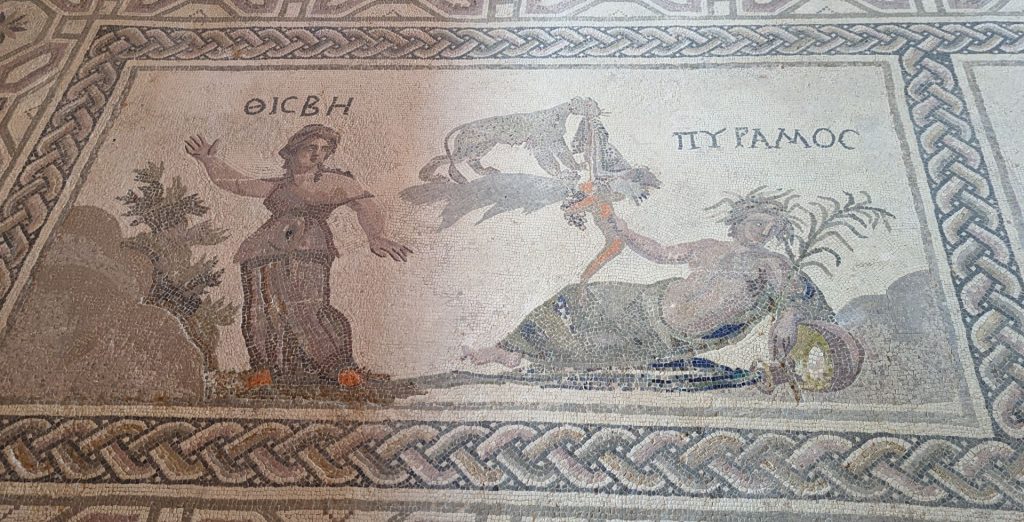
The next mosaic features wine. Yes! The story goes that Icarus showed hospitality to god Dionysus and in return Dionysus taught Icarus how to grow vines and make wine. Dionysus warned Icarus not to let other folks know about the wine, but did Icarus listen? No! He filled a cart to the brim with bags of wine! He shared some with two shepherds. The two shepherds (on the right side of the mosaic) drank too much and, feeling the effects, thought Icarus had poisoned them, so they killed him. The inscription above the heads of the shepherds reads “the first wine drinkers.”
Dionysus is pictured on the left. He is with Akme, a nymph who personified culmination and perfection, who is drinking wine. Icarus appears to be gesturing to Akme, possibly indicating that this is the proper way to drink wine (i.e., not to excess).
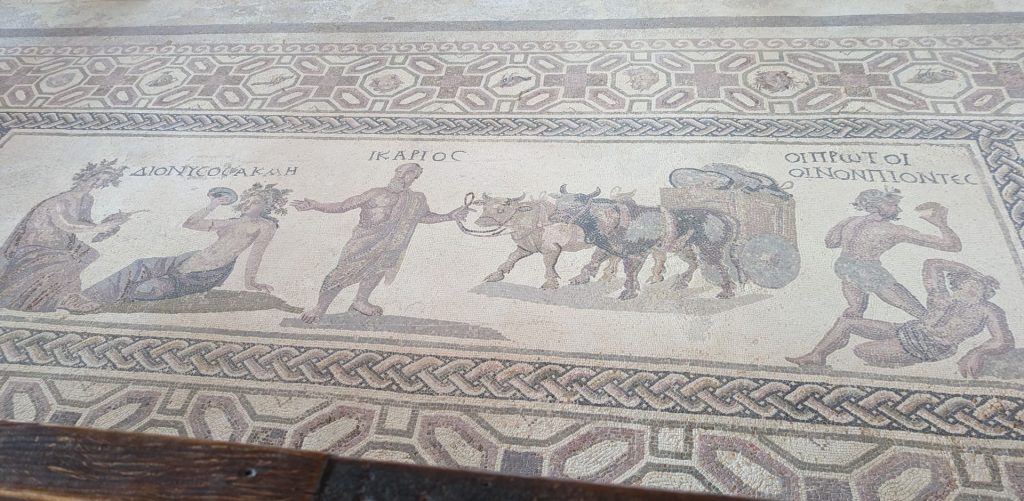
The following mosaic depicts Neptune and Amymone. Amymone was one of the 50 (!) daughters of king Danaos in Peloponnesus. At one point, all of the springs dried out so Danaos sent his daughters to look for water. Amymone met a satyr along the way who tried to ravish her, but Neptune, god of waters, helped her. Neptune was charmed by her beauty so he showed her to the spring of Lerna, which ended the drought. The other character in the picture is Eros, who holds a rectangular parasol in one hand and a torch in the other. The metal jug in the center symbolizes water.
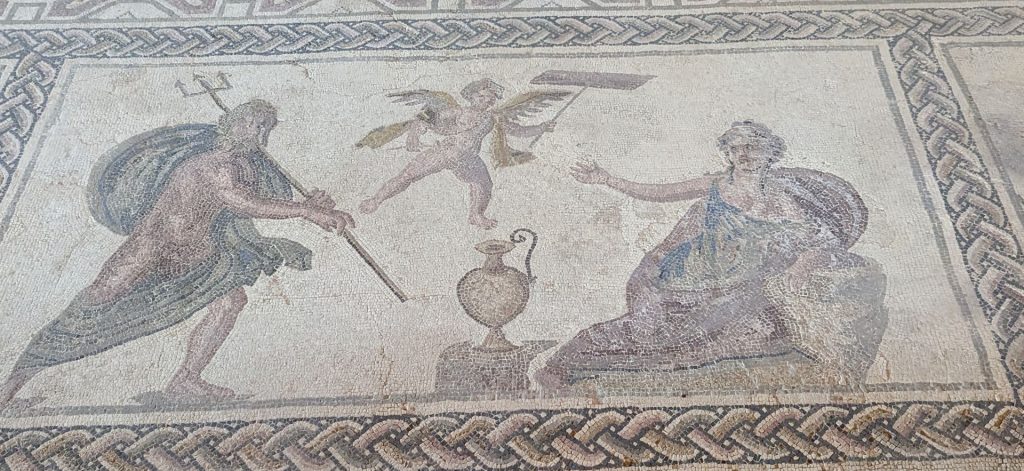
The next one is a sad story. The figure in the middle is Daphne, a Nymph, daughter of the River Peneus, who had sworn eternal chastity. But the God Apollo fell in love with her and chased her. Daphne asked her father to help her, and her feet immediately rooted to the ground. Her body then turned into the trunk of a tree and her hair and arms the branches and leaves. I can’t imagine that’s what she had in mind when she asked good ol’ Dad for help. In the mosaic, Peneus is reclining on the left side, Daphne is in the middle in the process of turning into a tree, and Apollo with a bow in his hand is watching in amazement.
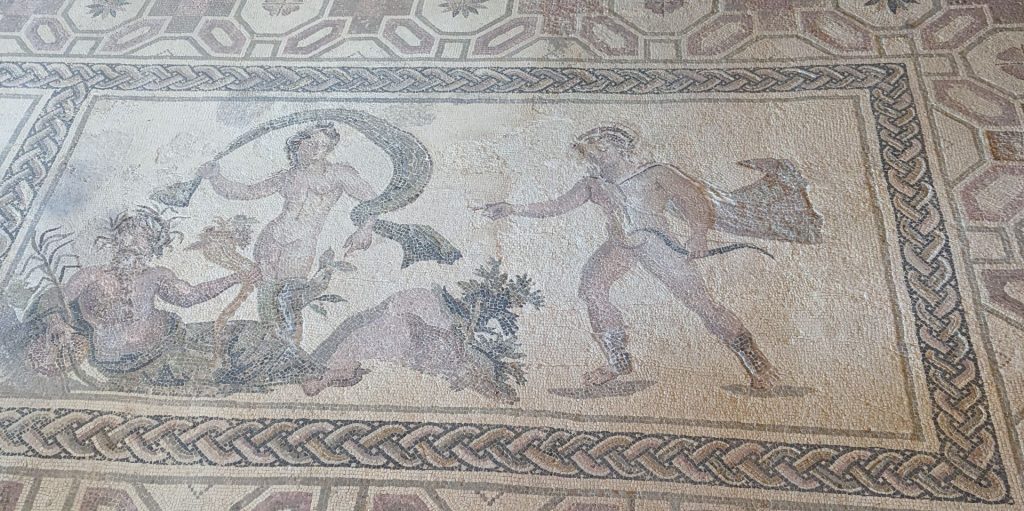
The next mosaic displays Phaedra, Hippolytus, Eros. . . and a dog (I don’t know why the dog is in it). Phaedra was the second spouse of the king of Athens, Theseus. Hippolytus was the son of Theseus’ first spouse, Antiope. Phaedra fell in love with Hippolytus (her stepson!) and when Theseus was away sent Hippolytus a love letter confessing her love. Hippolytus didn’t respond. I think this is a good thing, but it made Phaedra nervous. When Theseus returned, Phaedra lied to him and told him that Hippolytus had sent her a letter confessing his love because she was afraid she would get caught as the author. (Another version I read indicated that she told Theseus that Hippolytus had raped her.) Theseus asked God Neptune to punish Hippolytus. Neptune sent a wild bull that frightened Hippolytus’ horse, which threw him to the ground, killing him. In another version, Neptune caused Hippolytus’ horses to be frightened by a sea monster and they dragged their rider to his death. In yet another version, Dionysus sent a wild bull that terrified Hippolytus’ horses, causing them to drag Hippolytus to his death. Anywho. . . after Hippolytus’ death, Phaedra killed herself.
The scene in the mosaic depicts Hippolytus with the letter, Phaedra sitting down, and Eros to her right, holding a burning torch symbolizing the passion burning in her heart. Eros is depicted only on her side, indicating that the feelings were not mutual.
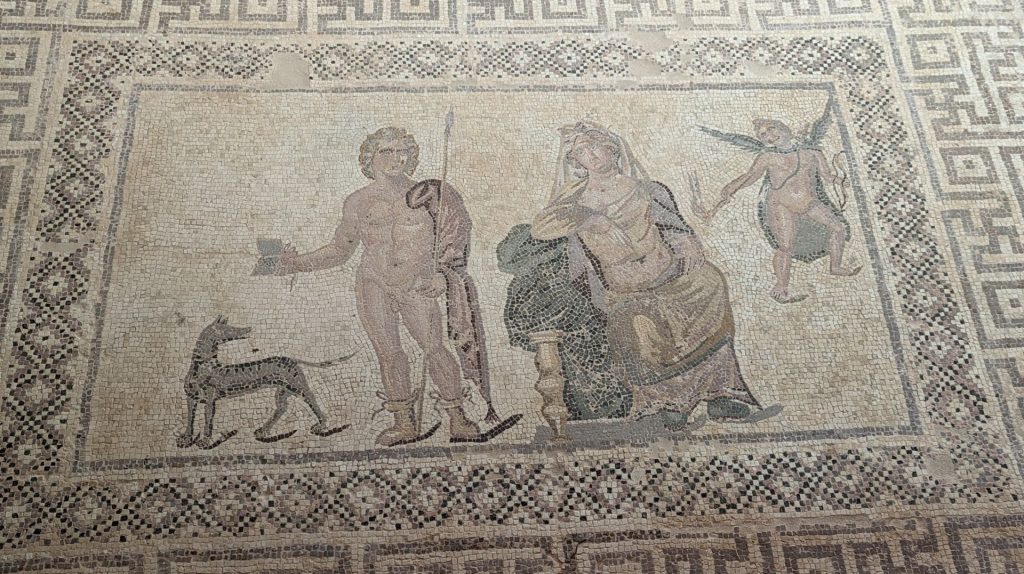
Do you remember another post where we shared a mosaic of Zeus carrying away Ganymede and we were wondering how in the world they got that since most of the image was destroyed? Well the House of Dionysus has the complete picture. I am guessing that the archeologists knew enough about the picture to recognize it in the other location. Who knows.
Here’s the entire thing. This is Zeus, in the form of an eagle, carrying away young Ganymede into the sky. Ganymede was a shepherd from Troy and was considered the most beautiful of all mortals. (Kind of like George Clooney once was.) Zeus decided to carry him away and bring him to Olympus where he became the cup-bearer of gods. I assume that is a good thing.
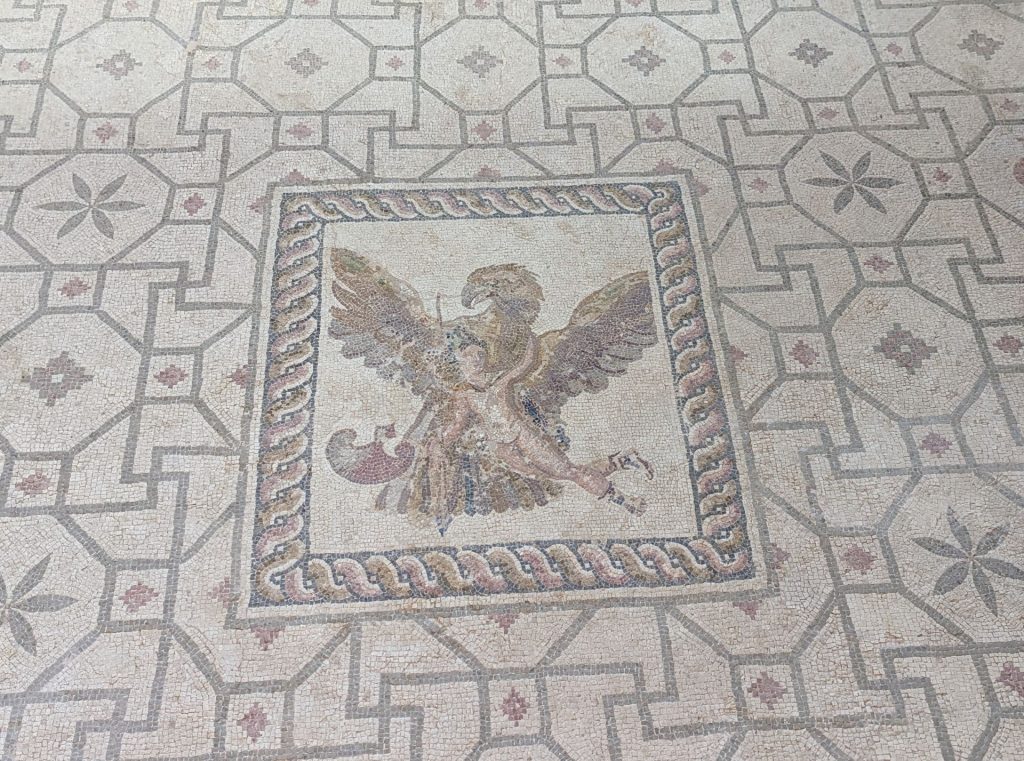
Another room had a floor with a design consisting of four rows and four columns, each square with a different geometric pattern. The wealth of colors and the complicated patterns make these panels particularly impressive. These were rare for the Eastern Mediterranean.
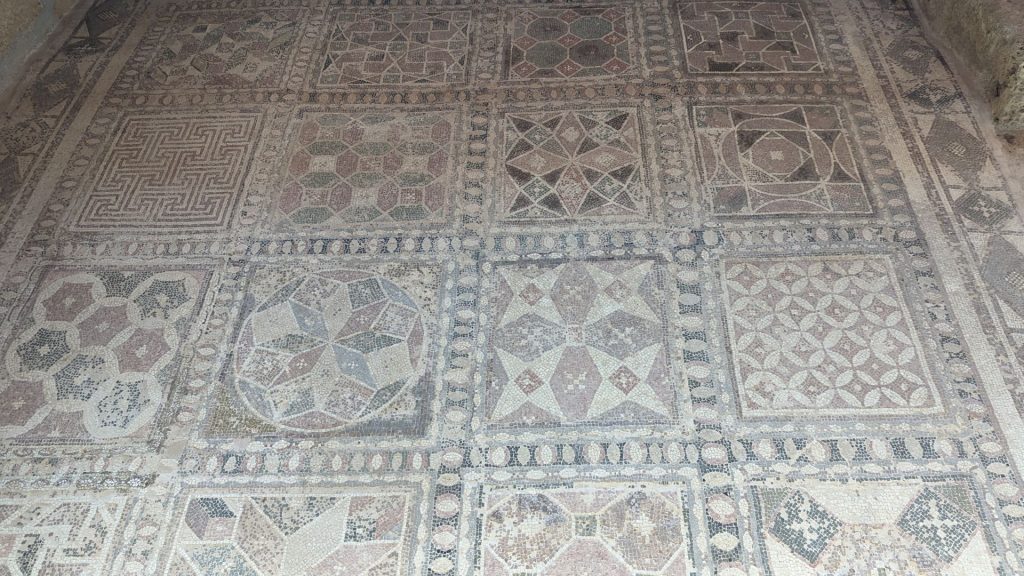
In a small room next to this there is a panel with an elaborate geometric pattern with a peacock in the middle. The blue in the peacock is not stone, but glass, probably manufactured in Pafos.
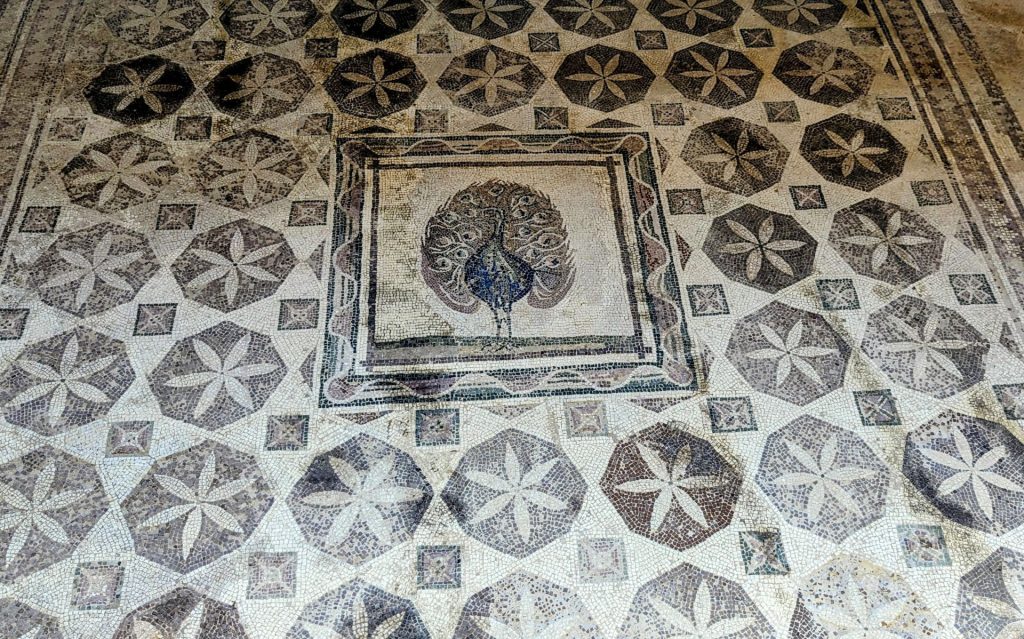
There is so much more in the House of Dionysus but I don’t want to bore you (any more than I already have?) so we will move to another structure.
The Villa of Theseus
This building is believed to have been the villa of the Roman proconsul of Cyprus. It was built at the end of the 3rd century A.D., destroyed by earthquakes in the 4th century A.D., rebuilt then completely destroyed and abandoned during the Arab raids in the 7th century A.D. Due to this history, architectural parts and mosaics originating from the 3rd, 4th, and 5th centuries A.D. exist.
It is the largest building of all known public buildings in the entire Roman Cyprus. It is 120 X 80 meters and consists of more than 100 rooms. Four wings are built around a colonnaded open courtyard. And, of course, there are baths. Cold baths, cold ablutions, and heated rooms where hot air passed from nearby fire chambers and heated the hypocaust floors of the moderately heated room, the steam bath, and the warm bath. There were also changing rooms, latrines, and rooms for anointing with essential oils. During their last years of operation, the baths were also used by the public. I think I would have spent a lot of time there had I been alive then.
Okay, now to the mosaics. This first mosaic was very large. The scene in the center is of Theseus (central figure) preparing to kill the Minotaur in the Labyrinth. Behind him is the personification of the Labyrinth in the form of an old man. There are also two feminine figures. Ariadne, daughter of King Minos, is to the left. She helped Theseus come out of the Labyrinth. Crete is to the right. The circular decoration around it depicts the figured representation of the Labyrinth. This is the most ancient mosaic of the 3rd century A.D.
Here is the story behind this according to Greek mythology. Theseus is the son of king Aegeus and one of the heroes of Athens. Athenians were compelled by Minos, king of Crete, to send seven young boys and girls every seven years as prey to the Minotaur, who lived in the palace’s Labyrinth. Theseus decided to travel with the young people to Crete to kill the Minotaur and stop this nonsense. King Aegeus agreed, and asked his son to replace the black cloths of the boat with white ones upon his return as a sign to the King that he (Theseus) is coming back alive. Upon his arrival in Crete Theseus offers to be sacrificed to the Minotaur first. Ariadne, impressed by Theseus’ bravery, falls in love with him and provides a weapon and ball of thread to aid his escape from the labyrinth. Theseus enters the Labyrinth in Crete, kills the Minotaur and comes out safe, thanks to the thread Ariadne gave him. He returns to Athens with Ariadne on the sailboat but they forget to replace the black cloths with the white ones. When King Aegeus sees the boat, he believes that his son is dead and he throws himself into the sea. That sea now bears his name: the Aegean Sea.
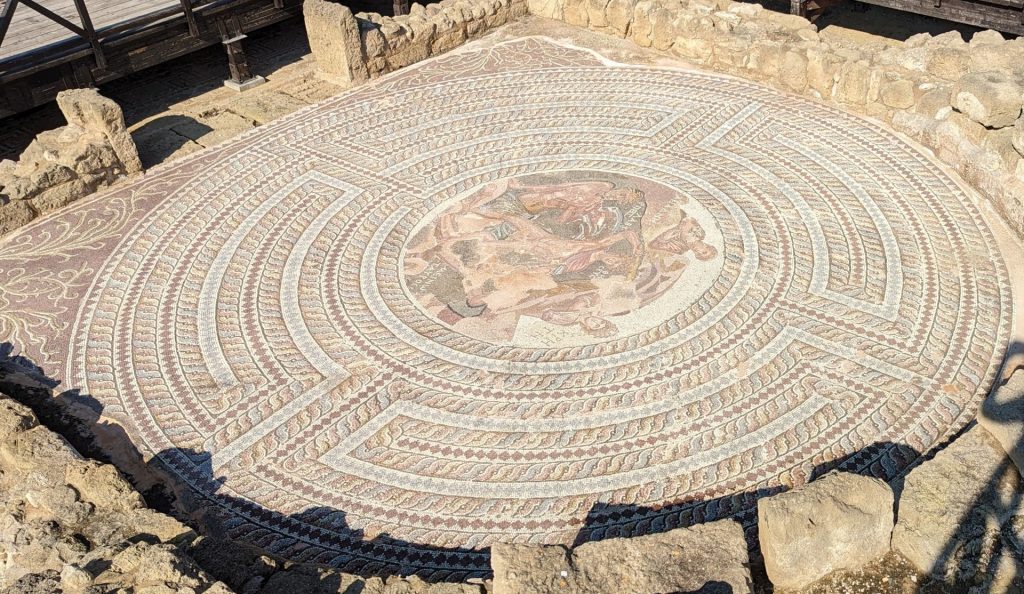
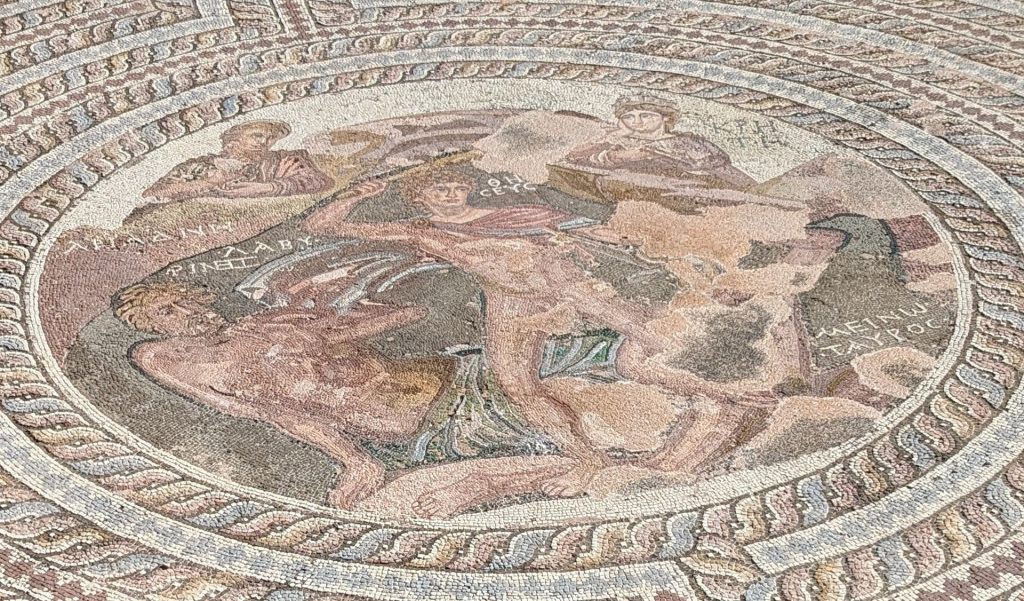
Unfortunately, I did not take a “straight on” picture of this next mosaic. You are seeing it from an odd angle. This mosaic was located in the main room of the palace that was used by the Governor as an officiating space. The front of the room had a mosaic floor with four panels, but only this one is well preserved. It represents the birth of Achilles. It dates to the 5th century A.D., a time when themes from the lives of heroes of Greek mythology were particularly popular.
Achilles was the son of Peleus, king of Myrmidons, and Thetis, daughter of Nereus, god of the waters. Thetis wanted to make Achilles immortal, so she bathed him in the waters of Styx. The only vulnerable point in Achilles’ body was his heel, where his mother held him. A wound received at that exact spot in his body during the Trojan War caused his premature death.
The scene in the mosaic depicts the birth of Achilles. Thetis reclines in the center with Peleus seated to her left. On the left hand side, a nurse holds Achilles and is preparing to give him his first bath. Behind Peleus are the three Fates: Clotho, Atropos, and Lachesis. The Fates were divinities in Greek mythology who presided over human life. Together, the Fates represented the inescapable destiny of humanity. Clotho spun the “thread” of human fate, Lachesis dispensed it, and Atropos cut the thread (thus determining the individual’s moment of death).
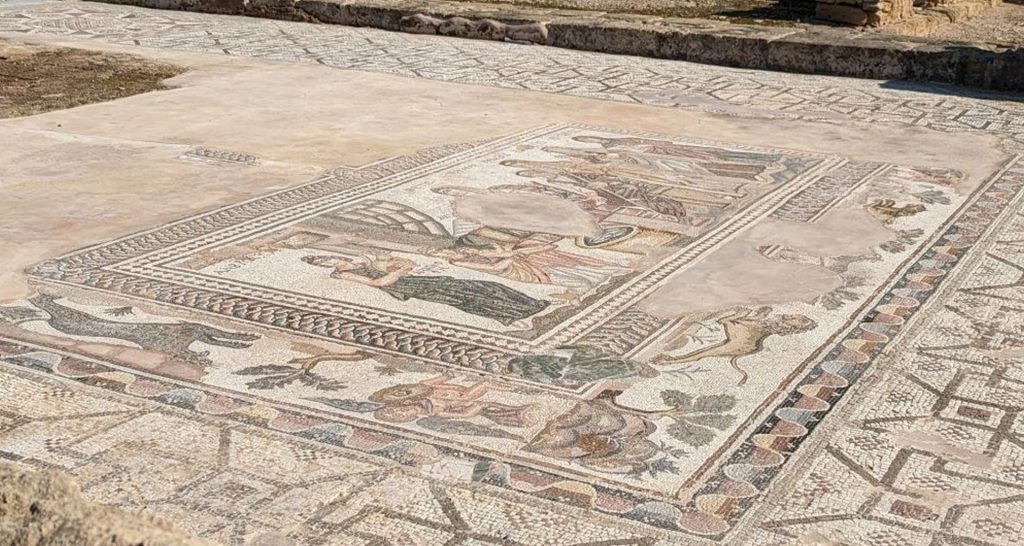
The last house from which we will share mosaics is the House of Aion. They are not done excavating here. The mosaics we are sharing are mythological representations. They are considered to be of fine workmanship: they are made from small tesserae measuring 2-5 mm and cover a great spectrum of colors.
Here is a picture of all six panels on the floor in the combined reception room and dining room.
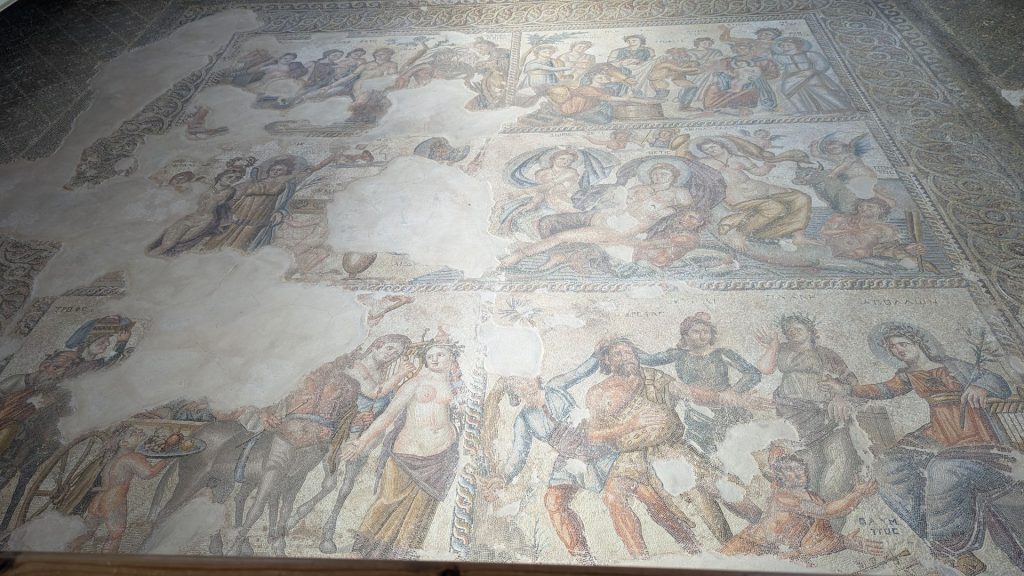
Below is a close-up of the top right panel. This represents the Epiphany of god Dionysus. Newborn Dionysus is sitting in Hermes’ lap while three nymphs prepare his bath. Also pictured are personifications of Theogonia, Nectar, Ambrosia, as well as Mount Nysa and Tropheus, the future tutor of the newborn. Interestingly, Dionysus is represented here as the god of Wisdom not the god of wine and joy. This is due to the time period in which this mosaic was made. These date from the beginning of the 4th century A.D., when Christianity began to spread in Cyprus. Also notice the nimbus around baby Dionysus’ head. Hmmmm.
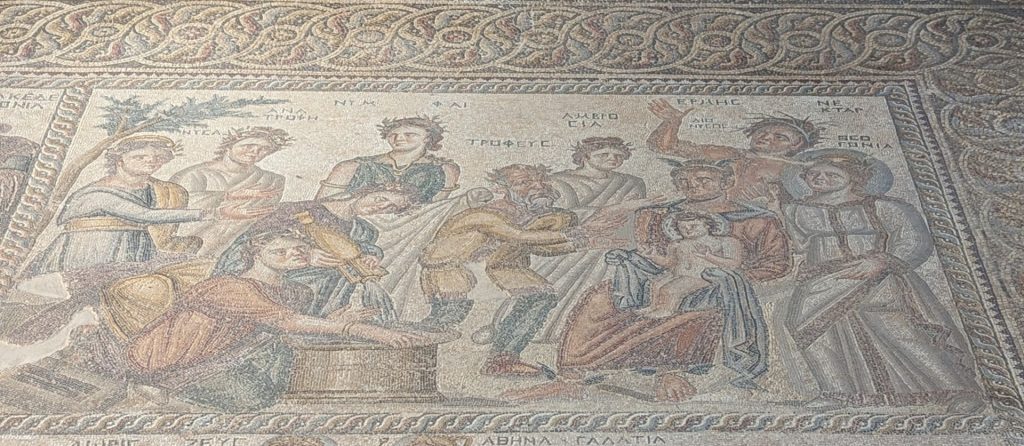
The bottom right panel is a representation of the punishment of Marsyas by god Apollo. Marsyas was a satyr who boasted that he played the flute even better than Apollo, god of music and patron of the Muses. Apollo challenged Marsyas to a contest with the Muses as judges. Apollo won. He punished Marsyas by condemning him to death. In the panel, Apollo is sitting on the right. Marsyas is the dude in the middle being brought by two Scythians. Plane is depicted next to Apollo as the personification of Marsyas’ errant mind. Olympus, Marsyas’ pupil, leans on Apollo’s legs imploring him to be merciful (he wasn’t).
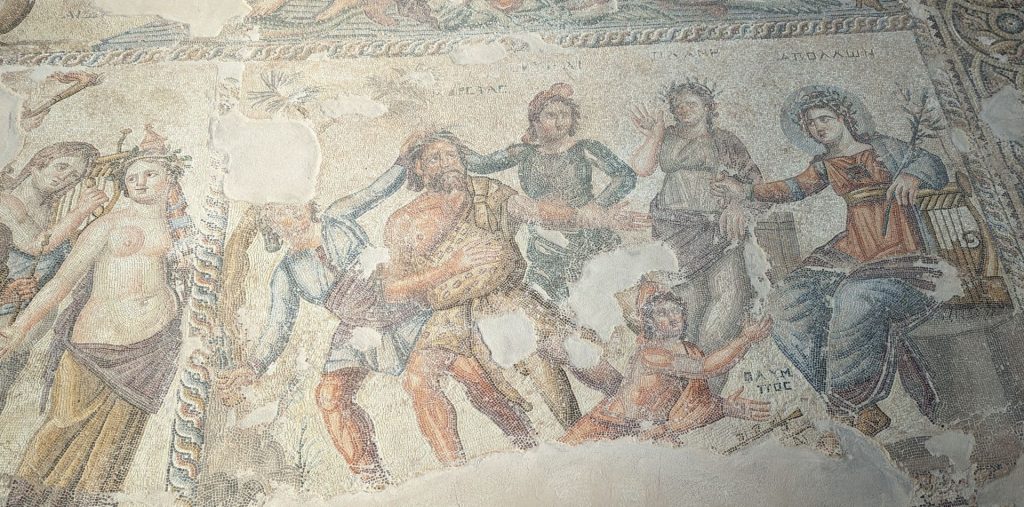
The archeological park also included a lighthouse, an agora, and a Roman Odeon:
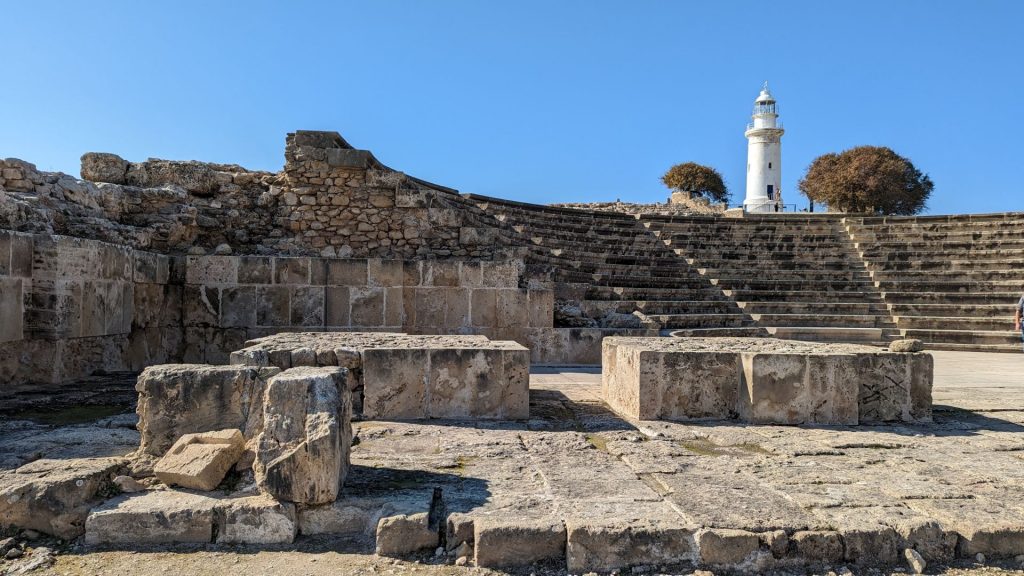
The last structure we are going to share with you is the Byzantine Saranta Kolones (Forty columns) Castle, or rather the remains of it. The original castle was built on the base of 40 granite columns, hence the name. The castle is believed to have been built at the end of the 7th century A.D. (some say 6th) to protect the port and the city of Nea Pafos from Arab raids, and was later remodeled by the Lusignans. It was destroyed and rebuilt a couple of times, then finally destroyed by an earthquake in 1222 (or 1223) and abandoned. The new Pafos castle was built by Pafos Harbor, which can be visited to this day.
The Fortress had a three-meter thick wall with four huge corner towers and another four intermediary towers along the joining walls and moat surrounding the castle. Access was across a wooden bridge spanning the moat. The square courtyard measured 35 X 35 meters.
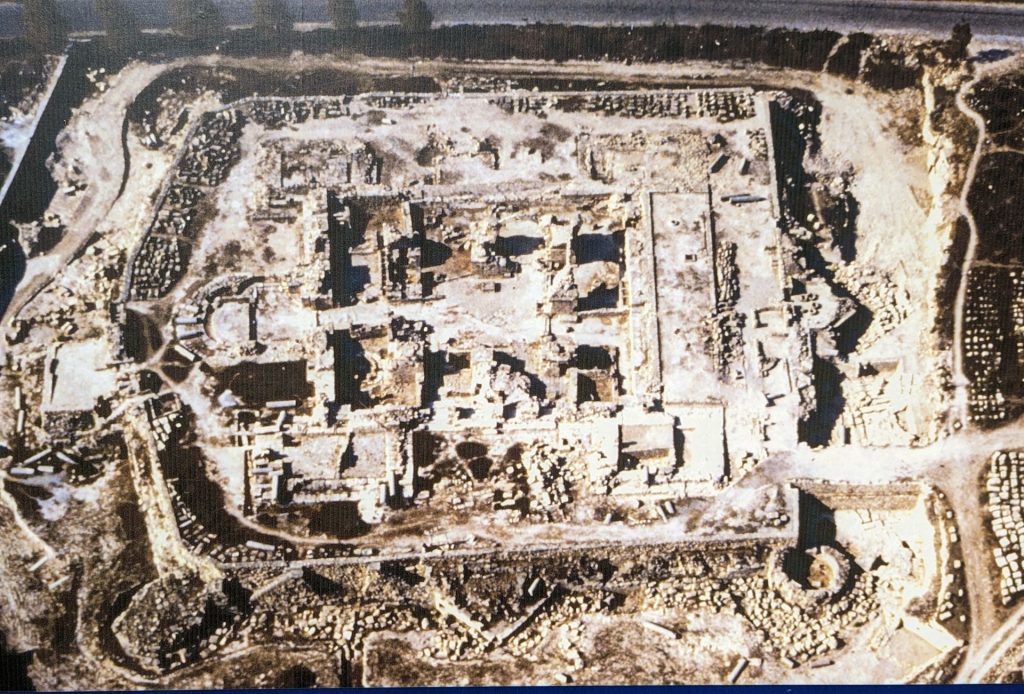
Here are some random pictures we took of the ruins.
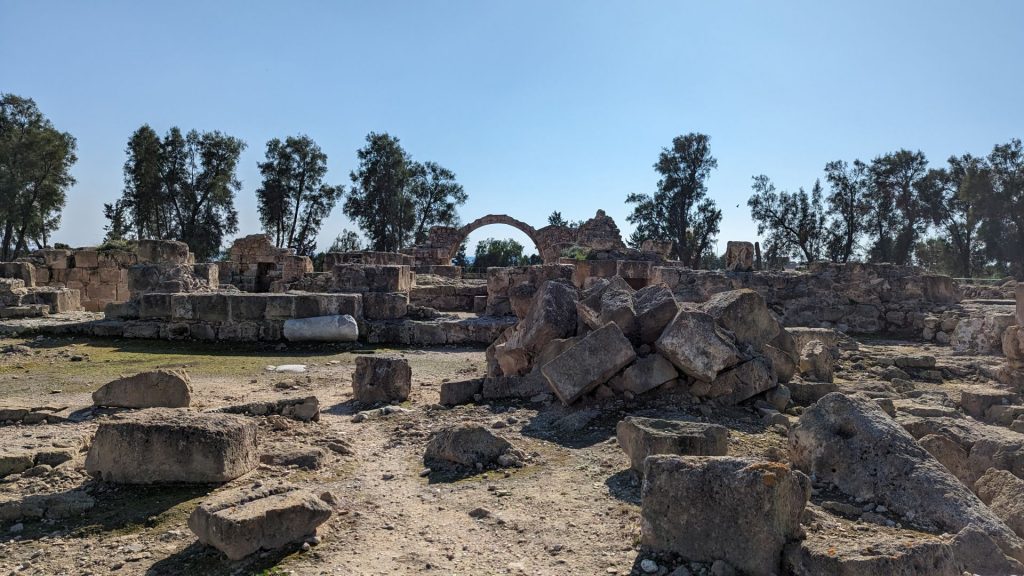
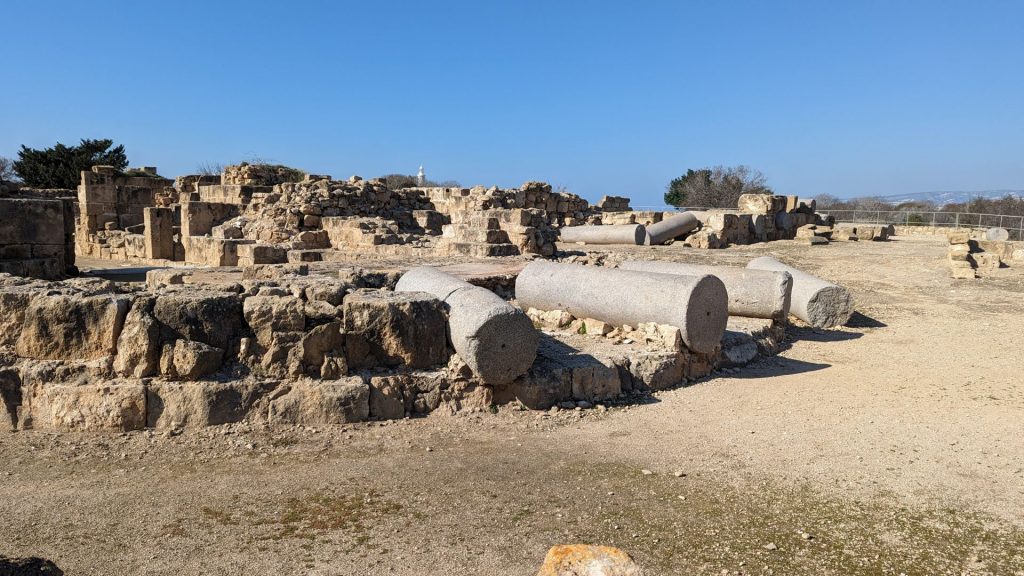
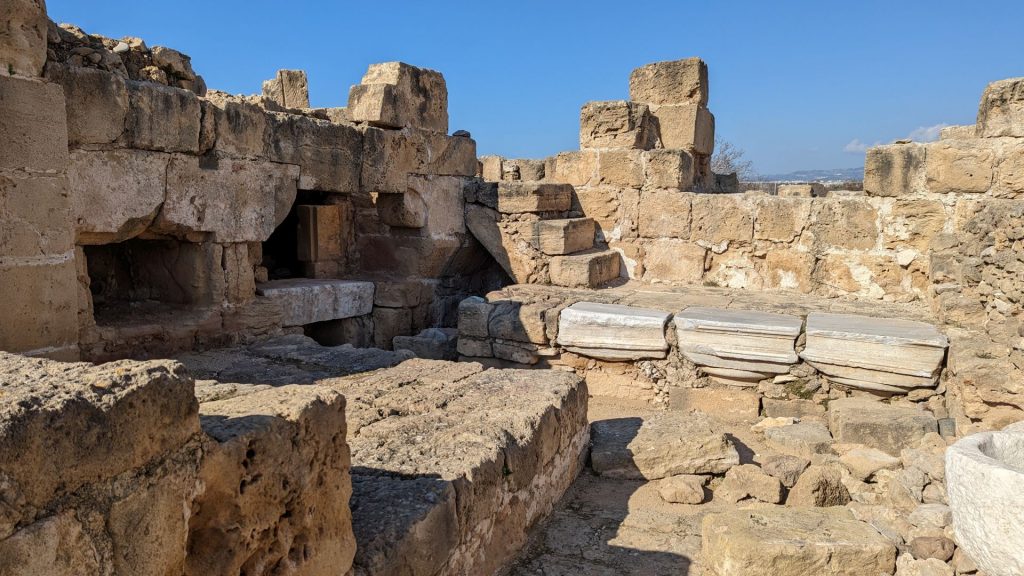
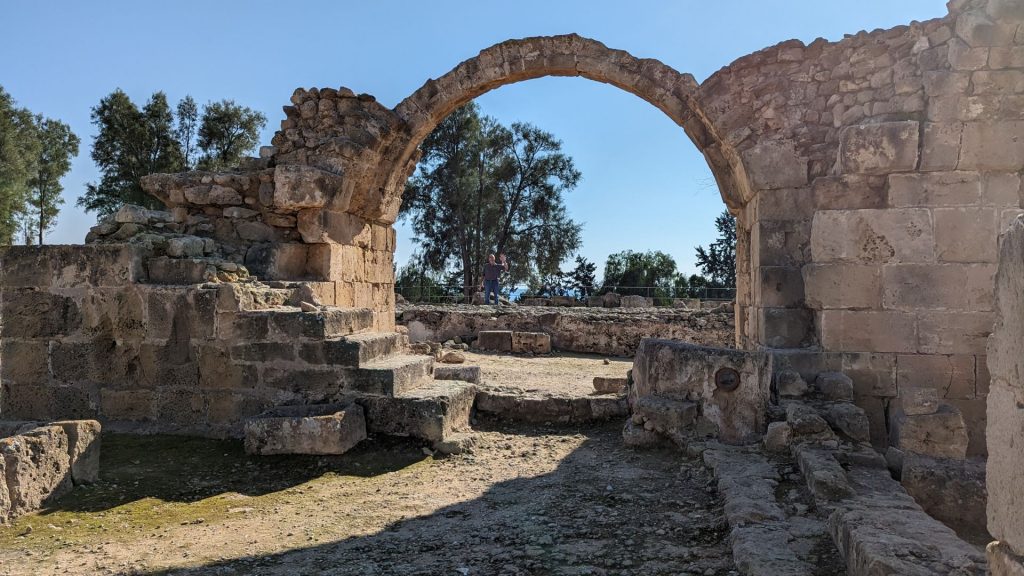
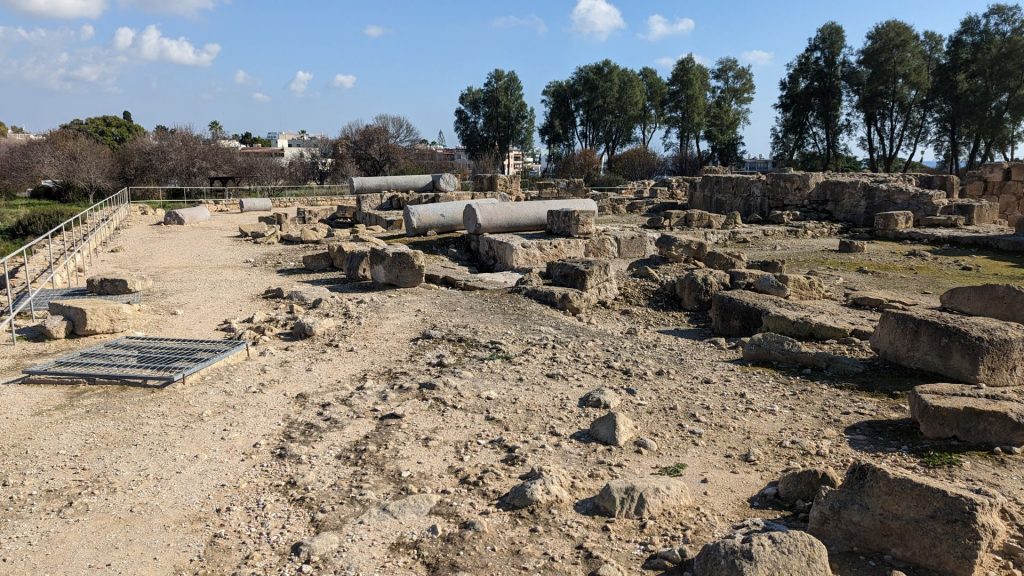
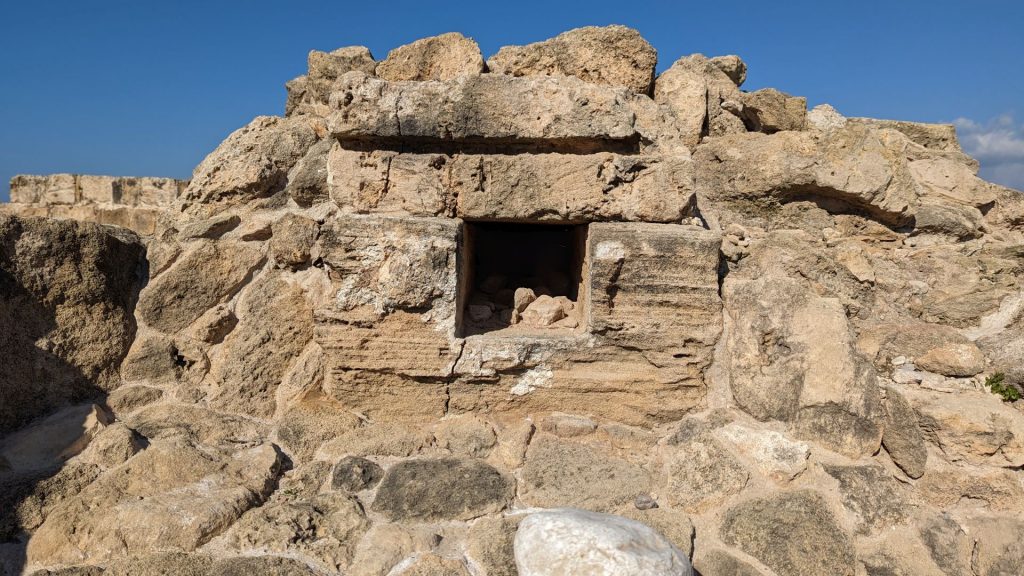
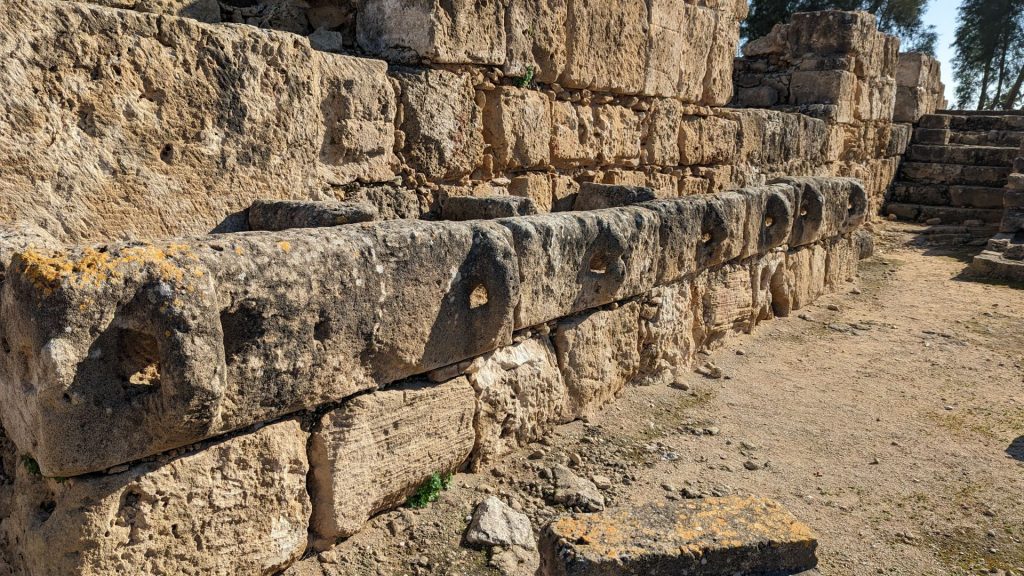
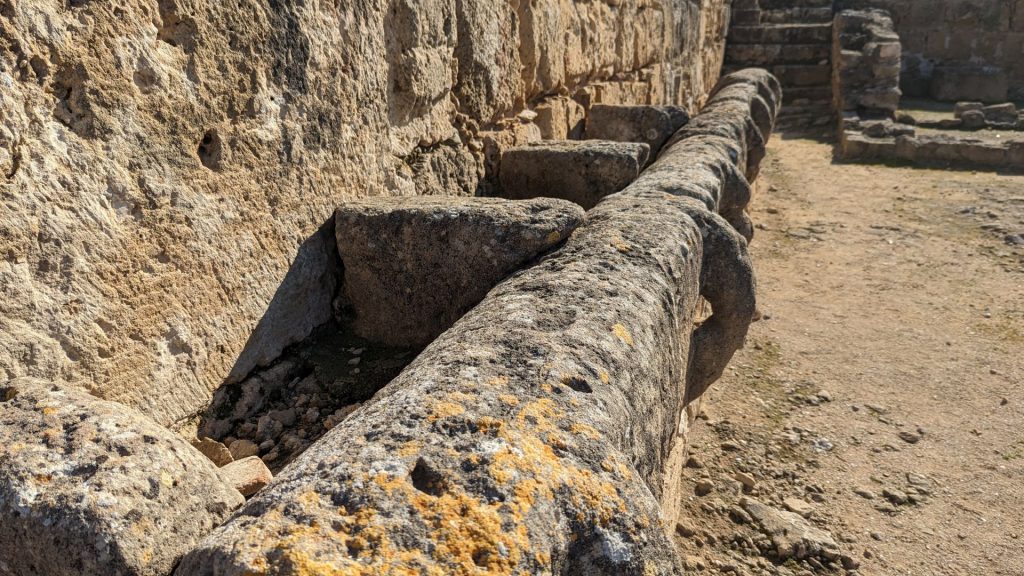
We also took a short visit to Pafos harbor. We saw the exterior of the Pafos Castle by the entrance but didn’t go in it. It is a nice harbor.
